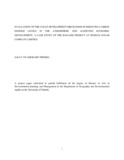| dc.description.abstract | Issues of climate change have become an integral part of our development plans and therefore how to respond to them while ensuring sustainable development has become an integral part in most of the world`s nations including Kenya. One mechanism, the Kyoto protocol, can play a very important role in reducing global warming and ensuring that countries are able to achieve sustainable development at their own national levels (UNFCCC, 2002). The Clean Development Mechanism (CDM) under the Kyoto protocol permits projects reducing emissions in the developing countries to earn certified emissions reduction credits for the developed countries.
The bagasse project at Mumias Sugar Company Limited is one of the CDM projects in Kenya whose aim since its inception in 2009 was to ensure that by avoiding dumping bagasse CO2 levels would reduce and grid electricity would be displaced with GHG-neutral biomass electricity generation. The overall GHG emission reductions expected from the project is 129,5914t CO2e over the period (2008-2018).
This study`s main objective was to evaluate if the bagasse project has reduced carbon dioxide (CO2) emissions through the use of electricity a renewable source of energy and avoiding bagasse decomposition as a result of accumulation. The specific objectives were; to determine the effect of the bagasse project on the levels of CO2 emitted, to examine how the company and the surrounding community have benefited economically from the project and to assess what challenges the bagasse project has experienced.
The study used longitudinal study design to collect primary data from cluster random samples of 45 respondents drawn from three groups of people working and living around Mumias Sugar Company Limited. Actual data was collected using a semi-structured questionnaire to get information on carbon dioxide levels and economic development enhanced by the project. Key informant interviews were applied to obtain first-hand data from selected respondents and to complement questionnaire data. Secondary data was collected from the company records and publications on the project by UNFCCC. Questionnaire data was entered and analyzed with the aid of the Statistical Package for the Social Sciences (SPSS) while data from interviews was analyzed using content analysis method.
The results showed that the project reduced CO2 emissions through the use of the increased renewable energy (electricity) produced and lack of accumulation of bagasse as it was all being used in the project. Initially before the project the company was able to export 2MW of electricity for 16 hours per day to the national grid (UNFCCC, 2010) but this increased to between 24MW and 28MW over the years (MSCL, 2017). In a monitoring study done by UNFCCC from 01/10/2008 to 30/06/2011 the project had generated 140,544.8 tCO2 and the plant had achieved a maximum of 30 MW power export to the grid although not on a continuous basis.
The project has improved economic development in the area by increasing supply of electricity thus accommodating for energy deficits, providing employment directly and indirectly, providing cattle feed and organic fertilizer and improving the environment. The results further indicated the project had also led the growth of other sectors such as agriculture, transport, industry and infrastructure.
The major challenges facing the project were inadequate raw materials, Ineffectual technology, and high transportation cost of cane, corruption and poor agricultural practices. The study established that corruption enhanced mismanagement of the company so that farmers were not paid in time making it hard for them to continuously supply cane on time stalling project activities due to lack of raw materials. The poor agricultural practices also led to reduced cane yield further contributing to reduced amount of raw materials.
The study concludes that the project was able to reduce level of carbon dioxide emitted and enhance economic development in the area. However the challenges the project has experienced have affected the achievement of the set goals in the given time. The study therefore recommends that these challenges be addressed and systems be put in place to make certain there is accountability and transparency in management of the project to prevent avoidable mishaps Further, development priorities of the local communities should be considered before commencement of any project to ensure project aims are compatible and able to address actual issues on the ground as a result ensure success. | en_US |



